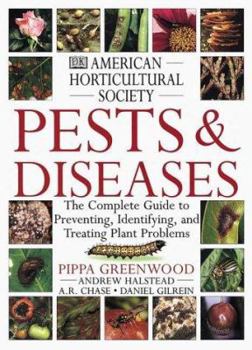American Horticultural Society Pests & Diseases: The Complete Guide to Preventing, Identifying, and Treating Plant Problems
Select Format
Select Condition 
Book Overview
Is your garden troubled by cutworms or aphids? Need to know the best method for preventing the spread of viruses among your houseplants? Look no further than Pests and Diseases, the informative guide... This description may be from another edition of this product.
Format:Hardcover
Language:English
ISBN:0789450747
ISBN13:9780789450746
Release Date:February 2000
Publisher:DK Publishing (Dorling Kindersley)
Length:218 Pages
Weight:2.39 lbs.
Dimensions:1.1" x 7.8" x 10.8"
Customer Reviews
5 ratings
Garden Reference
Published by Thriftbooks.com User , 17 years ago
This book is an excellent reference for the gardener and was as represented. I regret not at all having purchased this volume and recommend it to anyone wanting such a reference in their library of garden-related books.
Great reference book
Published by Thriftbooks.com User , 19 years ago
This book was purchased for a plant pathology and entomolgy class I am taking. This has been completely invaluable as a reference book for any sort of disease or insect identification.
A Good Supplemental Guide for Gardeners
Published by Thriftbooks.com User , 19 years ago
The organizational structure of this guide to identifying and treating plant problems makes navigating the many causes of damage easy. The first section contains thumbnail photographs of specific problems, arranged by plant parts affected: leaf problems; stem and bud problems; flower problems; fruit, berry, nut, and vegetable problems; soil, root, tuber, and bulb problems; and lawn problems. The book then follows the problems with a brief photographic section of beneficial insects so gardeners do not kill off the bugs that help maintain environmental balance. Good gardening habits, including soil and nutrient analysis and pest/disease control, are given adequate space. The bulk of the book, however, is the A to Z guide which describes symptoms, cause, and control of just about every garden problem. Readers are expected to first identify the problem using the photographs in the beginning section and then turn to more information in the A to Z guide. The problem is, different plants with the same disease may not appear anything like the chosen (and small) photograph. Diagnosis is sometimes difficult. The index to individual plant problems is somewhat of a help to rule out similar problems that don't affect the plant in question, but I found myself wishing that this guide were a little more complete. Recommended treatment is most often organic -- removing pests by hand, using insecticidal soap, introducing beneficial insects, or removing all affected plants. My favorite suggestion for wasp control is to vacuum them from their nests, seal the vacuum bag, and stick it in the freezer to kill the wasps. I'm sure my family would just love to have dying wasps next to the ice cream. Fortunately, most suggestions are not as impractical; they maintain a regard for both plant and human health. When true pesticides are the only recourse, the books refers to them as "labeled insecticides" without specifying which kind would be effective. (For pesticide users, try an Ortho book instead.) I found that this book makes a good supplement to my other gardening books. Very few books are dedicated to pests and diseases, making this a valuable resource for the gardener. I recommend pairing this book with Princeton University Press's Garden Insects of North America.
Invaluable resource
Published by Thriftbooks.com User , 21 years ago
While this book is not the type most people curl up to read on a cold winter's night, I found it to be a very worthwhile resource for any garden. You can research any problem by either plant or by symptom. Each section is color coded along the page edge for easy use. The pages on Individual Plant Problems are separated into sections like "Garden Trees" or "Bulbs", and then alphabetically listed by common name and the name of the problem. The Gallery of Symptoms allows you to look at general problems with a particular part of the plant, such as leaves, stems, or fruits. Full color photographs accompany each symptom or pest, as well as a listing of types of plants affected and the season of affect. A short description follows with the page number for a full description and the recommended treatment.
GOOD & GROSS!
Published by Thriftbooks.com User , 24 years ago
First off, if you can not stand the sight of a bug, this is not for you. I am a horticulture student who loves plants but hates pests! I got this book for a class and it is great! All gardeners shoud have this book close by at all times! It is an indespensible refrence for anyone who wants to have a happy healthy garden. I love the way the book is organized by a "Gallery of Symptoms" in the begining. This is a section of close up pictures of leafs, fruits, nuts, vegetables and flowers with all the pest (disese and bug)problems I ever (never) wanted to see. It is so disgusting that my friends will not go near the book! However, I am excited to try the various non-chemical controls the book readily provides. A holostic aproach seems to be the theme of the A-Z directory in the second half which gives me comfort in gardening... not just for me but the birds, bees and other GOOD critters in the garden. Happy hunting! (Slugs here in the N.W.)





